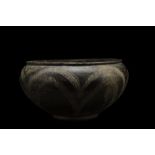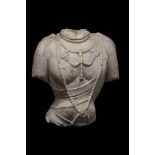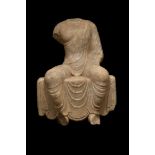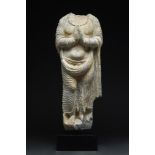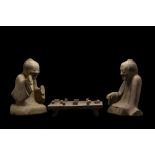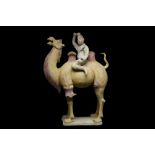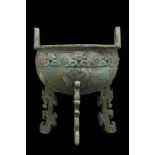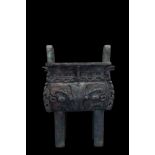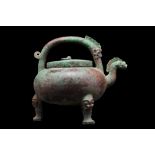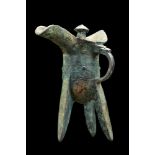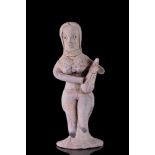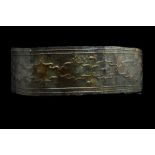Verfeinern Sie Ihre Suche
Schätzpreis
Kategorie
- Jewellery (92)
- Greek, Roman, Egyptian & Other Antiquities (85)
- Arms, Armour & Militaria (56)
- Sculpture (41)
- Ceramics (39)
- Coins (37)
- Chinese Works of Art (28)
- Glassware (25)
- Books & Periodicals (16)
- Salvage & Architectural Antiques (14)
- Porcelain (13)
- Collectables (9)
- Taxidermy & Natural History (6)
- Vintage Fashion (6)
- Classic Cars, Motorcycles & Automobilia (4)
- Furniture (4)
- Metalware (4)
- Textiles (4)
- Lighting (2)
- Islamic Works of Art (1)
- Musical Instruments & Memorabilia (1)
- Oil, Acrylic paintings & Mixed Media (1)
- Scientific Instruments (1)
- Stamps (1)
- Tools (1)
- Liste
- Galerie
Ein Abonnement der Preisliste ist notwendig um Ergebnisse, von Auktionen die vor einem längeren Zeitraum als 10 Tagen stattgefunden haben, ansehen zu können. Klicken Sie hier für mehr Informationen
Ca. 600-800 AD. A wearable, religious gold pendant in a circular form with a beaded border enclosing a relief decoration of two doves facing each ...
Ca. 500-700 AD. A beautiful circular gold pendant inset with garnets, framed with a beaded edge and flanked by a pair of opposing suspension loops...
Neo-Classical, Ca. 1800-1900 AD. A lovely brooch composwed of an Alexander III the Great silver, authentic 4th C BC drachm, set in fine 18K yellow...
Ca. 1800 AD. A carnelian intaglio of ovoid form, skillfully incised with a depiction of God Mars wearing his military attire, set in an elaboratel...
Ca. 1800 AD. A gold discoid pendant with an intricately decorated border of concentric filigree bands enclosing a central sardonyx cameo of a left...
Ca. 1000 BC. A votive figure of a bull in a layer of sheet silver. The animal is standing in a naturalistic position, the thick muscular neck with...
SOUTH ARABIAN ALABASTER BULL
Ca. 300 BC - 100 AD. A finely carved alabaster freestanding bull figure depicted standing alert on all four legs with nicely detailed hooves. The ...
Qataban, Ca. 300 BC - 100 AD. An alabaster funerary stele with a slightly tapering profile towards the bottom, with a high relief bovine head proj...
Ca. 300 BC. A funerary stele, polygonal in form, sculpted in low relief with a face head with almond-shaped eyes, a prominent long triangular nose...
Ca. 3000-2500 BC. A large terracotta vessel sitting upon a flat circular base from which a globular body rises upwards and terminates in a wide op...
Ca. 3rd Millennium BC. A finelly modelled vessel which has been wheel made with a globular base. Its black glaze radiating with a zoomorphic incis...
Ca. 1st Millennium BC. Ca. 1st Millennium BCA beautiful necklace of carnelian and agate graduated beads highlighted by 6 hollow coin-like beads an...
RARE SASANIAN GOLD SIGNET RING
Ca. 400-600 AD. A rare gold finger ring comprising a highly decorative hoop of a flat-section band, expanding to support an oval-shaped bezel engr...
BRONZE AGE GOLD COILED RING
Ca. 1000-800 BC. A hollow-formed gold ring with a rounded outer face with a slight carination and a flat inner face, with tapered and overlapping ...
Ca. 550-330 BC. A beautiful bracelet made of a hollow shank formed of silver sheet. The shank features a round-section body with terminals in the ...
Ca. 550-330 BC. A beautiful bracelet made of a hollow shank formed of silver sheet. The shank features a round-section body with terminals in the ...
Ca. 618–907. Chinese Tang Dynasty (or later).. A beautiful marble torso of a bodhisattva elegantly adorned with an astonishing jewelled harness ma...
Ca. 618–907. Chinese Tang Dynasty (or later).. A beautiful marble statue of a seated bodhisattva depicted wearing voluminous robes elegantly drape...
Ca. 200-300 AD. A grey schist carving of a standing Buddha. This excellent figure is backed by a circular halo and dressed in a flowing Kasaya (mo...
Ca. 200-300 AD . A remarkable example of Kushan artistry, richly carved in grey schist, combining naturalism of the classical Greek style with the...
Ca. 100-300 AD. A schist stone head of a Buddha. He is depicted with wavey hair gathered up in a topknot above a headband. His face characteristic...
Ca. 206 BC - 220 AD. A set comprising two players and a Liubo board with playing pieces. Both figures are shown in a seated position. They are dre...
Ca. 618-907 AD. An earthenware mingqi of a foreign rider on a camel modelled in a standing pose. The rider is depicted with his body facing outwar...
Late Shang/Early Western Zhou Dynasty, Ca. 12th-11th Century BC. Cast in relief with taotie masks and leiwen, on three bird-shaped flattened profi...
Late Shang Dynasty, Ca. 1300-1100 BC. A bronze cauldron, generally known as a ding. The object comprises a rectangular body with a shelved rim and...
Eastern Zhou Dynasty/Warring States Period, Ca. 475-221 BC. The heavily-cast vessel, with a spherical body, supported on three feet (which resembl...
Late Shang Dynasty, circa 11th Century BC. This rare and unique vessel contains a U-shaped body rising from three splayed triangular blade tripod ...
Ca. 300 BC. A flat stone offering table with one edge ending in a bovine head with its head down. Through the upper face of the altar and the bull...
Ca. 300 BC. An alabaster funerary stele sculpted in high relief with a male head with eyes, recessed for inlays, prominent eyebrows merging into a...
BALUCHISTAN SEATED MUSICIAN
Central Asia, Ca. 2nd millennium BC. A pottery female figure seated upon a flare-base seat, playing a stringed musical instrument, held on her lef...
SUMERIAN HUMBABA POTTERY MASK
Ca. 3500 BC. A pottery grotesque head with a prominent nose and grimacing mouth, depicting Humbaba. In Sumerian and Akkadian mythology, Humbaba wa...
WESTERN ASIATIC STONE EYED IDOL
Ca. 3700-3500 BC. An attractive grey-coloured stone Tell Brak Eye Idol consisting of a bell-shaped body, supporting two drilled circular eyes. Ido...
WESTERN ASIATIC STONE EYED IDOL
Ca. 3700-3500 BC. A rare alabaster Tell Brak Eye Idol consisting of a flat trapezoidal body, recessed at the top for the neck and surmounted by tw...
ANCIENT BRONZE URARTU BELT
Ca. 1000–650 AD. . Western Asiatic, Urartu. A rare, intact bronze belt made of a wide lateral bronze band embellished with geometric, floral decor...
Ca. 1600-800 BC. A bronze shield boss also known as an umbo, of a circular form, with a raised and pierced domed centre and a broad flat flange ni...
Ca. 1600-800 BC. A circular shield boss (umbo) with a raised central section pierced for attachment. The surrounding flange is decorated with a re...
SASANIAN DECORATED SILVER BOWL
Ca. 224–651 AD.. Sassanian. A hemispherical bowl hammered from one sheet. The interior is decorated with a medallion showing a gilded animal surro...
Ca. 3100-2900 BC. Early Bronze Age, Ca. 3100-2900 BCA Holy Land storage vessel with a spherical body and two ledge handles. The vessel has a wide,...
Ca. 3100-2900 BC. A Holy Land storage vessel with a spherical body and two ledge handles. The vessel has a wide, slightly out-turned mouth, decora...
Ca. 3100-2900 BC. A storage vessel formed of a light terracotta with a spherically shaped body and seven protruding nodules for decoration. The ve...
SYRO-HITTITE POTTERY BEAKER
Ca. 2nd millennium BC. A pottery beaker with globular-shaped body with four individual protruding faces with stylised round applied eyes and open ...
HOLY LAND POTTERY TREFOIL JUG
Middle Bronze Age, Ca. 1950-1730 BC. A fine example of a coil-made red burnished pottery jug with globular, almost amphora-like body, with a trefo...
AMLASH POTTERY SPOUTED JAR
Ca. 1st millennium BC. A pottery jar with bulbous shaped body and long protruding spout with applied loop underneath. The body with a long extendi...
HOLY LAND CANAANITE POTTERY JUG
Middle Bronze Age IIA, Ca. 2000-1730 BC. A burnished cream slip pottery jug with a piriform body and button-shaped base. The surface is decorated ...
Ca. 1600-1400 BC. A nicely modelled terracotta bowl, featuring smooth sloping sides and finger-pinched decoration. The thin walls of the bowl flar...
HOLY LAND CREAM BUFF BOWL
Middle Bronze IIB-C, Ca. 1730-1550 BC. A finely sculpted, pottery bowl in cream buff with a carinated shoulder from which the walls of the body ta...
Ca. 3000-2500 BC. A fine example of a monochrome Indus Valley civilization pot with a bulbous body rising from an undecorated conical-shaped base....
Ca. 3000- BC. A nice example of a squat bowl with a biconvex body on a ring base and a short, raised rim. The upper part of the body is decorated ...
Ca. 3000- BC. A terracotta bowl or vessel, comprising a biconvex body resting on a ring foot. The upper portion of the buff coloured vessel is dec...
IRANIAN POTTERY SPOUTED JAR
Iron Age II, C.a 1050-800 BC. With a globular round body, a ring base, a carinated shoulder, a rounded rim and a basket handle. A tubular spout em...
BACTRIAN STONE BOWL
Ca. 3000 BC. A bowl of globular shaped proportion; the base sloping to a narrow ring foot decorated with an incised line of decoration. The bowl i...
HOLY LAND BURNISHED JUG
Ca. 3rd Millennium BC. A Holy Land jug set on a low ring foot with a squat, globular body and a long vertical handle that begins at the widest par...
Ca. 600-800 AD. A Judeo-Aramaic terracotta bowl of a flaring body densely inscribed with lines of incantations against evil spirits. It is written...
Ca. 600-800 AD. A Judeo-Aramaic "devil trap" terracotta bowl with black lines of inscription spiraling around the interior. Bowls like this exampl...
Ca. 600-800 AD. A Judeo-Aramaic terracotta bowl of a flaring body densely inscribed with lines of incantations against evil spirits. It is written...
Ca. 600-800 AD. A Judeo-Aramaic "devil trap" terracotta bowl with black lines of inscription spiraling around the interior. Bowls like this exampl...
Ca. 600-800 AD. A Judeo-Aramaic terracotta bowl of a flaring body densely inscribed with lines of incantations against evil spirits. It is written...
Ca. 2112-2095 BC. A nearly rectangular in shape brick fragment, inscribed with a central square of four columns of cuneiform text, "Ur-Nammu, king...
Ca. 3100-2900 BC. A pictographic tablet, rectangular in form, with lines of proto-cuneiform written in columns, recording the administrative accou...
Ca. 560 BC. A terracotta temple foundation brick of Babylonian King Nebuchadnezzar II, rectangular with thirteen columns of cuneiform text mention...












